Self-publishing
Self-publishing is the publication of media by its author without the involvement of an established publisher. The term usually refers to written media, such as books and magazines, either as an ebook or as a physical copy using POD (print on demand) technology. It may also apply to albums, pamphlets, brochures, video content, and zines.
In the traditional publishing model, the publisher bears all the costs and risks of publication, but retains most of the profit if the book is successful. In self-publishing, the author bears all the costs and risks, but earns a higher share of the profit per sale.
The $1 billion market of self-publishing has transformed in the past two decades with new technologies providing increasing alternatives to traditional publishing.[1] Self-publishing is increasingly becoming the first choice for writers.[2] Most self-published books sell very few copies.[3] Those which sell large numbers are newsworthy because they are so rare. The quality of self-published works varies considerably, because there are no barriers to publication and no quality control.[4]
History
Early examples
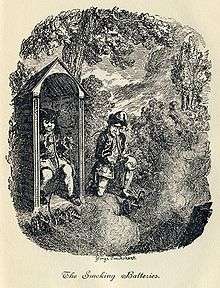
Self-publishing is not a new phenomenon. While most novels were distributed by established publishers, there have been authors who chose to self-publish, or even start their own presses, such as John Locke[5], Jane Austen, Emily Dickinson, Nathaniel Hawthorne, Martin Luther, Marcel Proust, Derek Walcott, and Walt Whitman.[6] In 1759, British satirist Laurence Sterne's self-published the first two volumes of Tristram Shandy.[6] In 1908, Ezra Pound sold A Lume Spento for six pence each.[6] Franklin Hiram King's book Farmers of Forty Centuries was self-published in 1911, and was subsequently published commercially. In 1931 the author of The Joy of Cooking paid a local printing company to print 3000 copies; the Bobbs-Merrill Company acquired the rights, and since then the book has sold over 18 million copies.[7] In 1941, writer Virginia Woolf chose to self-publish her final novel Between the Acts on her Hogarth Press, in effect starting her own press.[6]
Negative stigma
Five years ago, self-publishing was a scar. Now it's a tattoo.
Until the advent of ebooks and POD technology, most self-published books were published through a vanity press,[9] so called because such authors were assumed to be egotistical writers, unable to accept their work was not good enough to be accepted by traditional publishers.[9] James D. Macdonald claimed that vanity publishing violated Yog's Law which states that "Money should flow toward the author."[10] Vanity publishing usually required a one-time payment of $5,000 to $10,000 to do a print run of 1000 books; these books usually ended up in boxes in a garage.[4]
Photographer-turned-publisher Max Bondi said that "investing in a project shows that you believe in it".[11] Nevertheless, part of the reason for the negative stigma is that many self-published books are of dubious quality, because they are written by authors who are still learning their craft, and have never been edited or even proof-read. For example, in 1995, a retired TV repairman self-published his autobiography in which he described how he had been stepped on by a horse when he was a boy, how he had been almost murdered by his stepfather when he was a young man in Mexico, and how his ex-wife had clawed his face with her fingernails. The repairman spent $10,000 to have his 150-page masterpiece printed up, and, for promotion purposes, he sent copies to a local library, to the White House, and to everybody with the repairman's same last name. These efforts did not lead anywhere; today, the book is largely forgotten.[12]
Self-publishing is still seen as a "mark of failure" by many.[13] The image of self-publishing has been improving and some feel the stigma is gone entirely,[14] while others feel it still has a way to go to cultivate respectability.[15] Book critic Ron Charles in the Washington Post complained that "No, I don't want to read your self-published book", citing concerns that self-published books lacked quality and were published by authors with little understanding of the audience or the market.[15] However rare breakaway bestsellers such as Fifty Shades of Grey[7] and The Martian were first self-published, helping to lend respectability to self-publishing in general.[16] Further, with new avenues of self-publishing, there are more opportunities for authors to break through directly to audiences.[17]
For decades, the literary world dismissed self-published authors as amateurs and hacks who lacked the talent to land a book deal. But that attitude gradually began to change with the rise of e-books and the arrival of Kindle from Amazon, which gave authors direct access to millions of readers.
— Alexandra Alter in the New York Times, 2016[17]
Technological changes
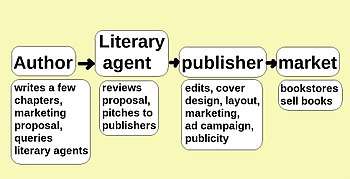
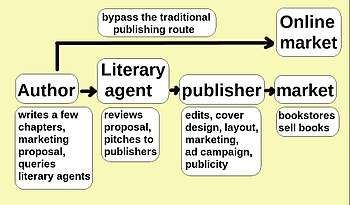
A huge impetus to self-publishing has been rapid advances in technology, particularly the exponential growth of the Internet and a general shift from analog to digital technology.[4] The Internet has been described as a "great equalizer" in the publishing world, since it enables an author to put their books out there and "stand naked before the world."[14] Costs for printing and distributing a book have fallen dramatically.[4][18] Advances in e-book readers and tablet computers have improved readability; such devices allow readers to "carry" numerous books in a small portable device.[4] These technologies make it possible to have a book printed or digitally delivered after an order has been placed, so there are no costs for storing inventory. Print-On-Demand (or POD) technology, which became available in the mid-1990s,[18] can produce a high quality product equal to those produced by traditional publishers; in the past, one could easily identify a self-published title by its lack of quality.[18] Print-on-demand was easy, since an author could simply upload a manuscript, choose an interior file format and a cover, and the book could be printed as needed, avoiding warehousing costs, and reducing the risk of being stuck with a huge unsold inventory.[18] Further, the Internet provides access to global distribution channels via online retailers, so a self-published book can be instantly available to book buyers worldwide. A Canada-based firm named Wattpad offers streaming video productions based on the stories of self-published authors as of 2017.[19]
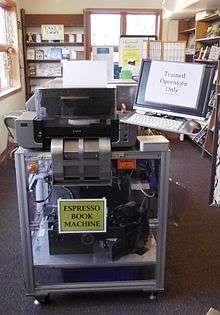
Internet transmission of digital books was combined with print-on-demand publishing with the invention of the Espresso Book Machine which was first demonstrated at the New York Public Library in 2007. This machine prints, collates, covers, and binds a single book. It is in libraries and bookstores throughout the world, and it can make copies of out-of-print editions. Small bookstores sometimes use it to compete with large bookstore chains. It works by taking two Internet-delivered pdf files, one for the text and one for the cover, and then prints an entire paperback book in a matter of minutes, which then drops down a chute.[20]
Amazon's introduction of the Kindle and its self-publishing platform, Kindle Direct Publishing or KDP, in 2007 has been described as a tipping point in self-publishing, which "opened the floodgates".[1] It was an "exclusively electronic self-publishing platform" which was e-book only, free for authors to upload their books, and gave authors control over how their books were priced as well as access to the same distribution channels as major publishers.[18]
Self-publishing today
In recent times the publishing industry as a whole is in a great deal of flux, in a sort of "Wild Wild West" state.[4] The online retailing giant, Amazon, has had a huge impact on the book-selling industry, driving many brick-and-mortar bookstores out of business and making inroads into publishing as well. Amazon has enticed readers away from bookstores and into an online environment, and its KDP and CreateSpace distribution channels have spawned a huge growth in self-publishing. As a result, the numbers of self-published authors are ever-increasing.[21]
There is an anti-establishment aspect to self-publishing, in that it has been seen historically as a way to defy authority or resist oppression.[22] The self-publishing movement can also be viewed as a part of the Do-it-yourself culture which "flourishes in environments of communitarian support."[22] A writer who is rejected by the usual system can find solace in self-publishing.[4] Some struggling authors complained that the traditional publishing model was too "insular", keeping out different ideas about stories as well as ones with unusual characters or plotlines, or which dealt with minorities, and self-publishing was a way for these formerly outcast writers to connect with readers.[23] Libraries have also become involved with self-publishing; the Library Journal and Biblioboard worked together to create a self-publishing platform called Self-e in which authors submit books online which are made available to readers. These books are reviewed by Library Journal, and the best ones are published nationwide; authors do not make money this way but it serves as a marketing tool.[24]
The dramatic changes have impacted the standard publishing industry as well, which is controlling a smaller share of the overall publishing market, forcing many traditional publishers to consolidate to reduce costs. The squeeze has been applied to such authors, some of whom have complained that traditional publishers have often asked for the author to contribute part of the start-up expenses personally, in effect deviating from the usual model of the publisher providing all upfront expenses.[11]
Self-publishing is still a "difficult and demanding way to go" but is increasingly becoming a respectable, if alternative, choice for a writing career.[18] Self-publishers who are savvy, motivated and hard-working, can build audiences and make money.[18]
Controversies and problem areas
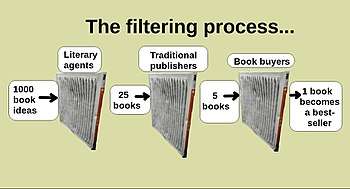
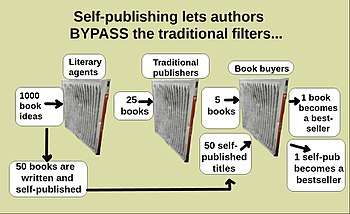
In the traditional publishing model, editors and publishers act as a filter or screen, weeding out possibly radical, badly written, or otherwise substandard content. In contrast, self-publishing enables authors to bypass this filter and sell their books directly to the public. The wide-open uncensored nature of self-publishing has caused problems and controversies with pornographic or abuse-themed content. Amazon has a policy against selling content relating to rape and incest and bestiality which states "We don't accept pornographic or offensive depictions of graphic sexual acts", but it is sometimes difficult for book distributors to distinguish what type of content is acceptable and what is not.[5] Some retailers have had to remove problematic content.[5] A survey found that self-published erotica had more extreme themes than mainstream books. Erotica is about 1% of the mainstream market but 29% of the self-published market, according to one informal survey in 2013.[25]
There have been some controversial self-published books, such as that of a man who posted a photo of his dead wife, whom he had murdered.[26] Celebrity Kim Kardashian self-published a 445-page book which consisted entirely of selfies, a book described in Slate magazine as having "no literary ambitions at all – it barely has words."[27]
While editors at a traditional publisher would often insist on fact-checking, and doing due diligence regarding claims made by an author, there are no requirements in the self-publishing model for this to happen. Self-publishing has attracted political provocateurs such as Milo Yiannopoulos who was able to publish his tome Dangerous on Amazon despite being dumped by traditional publisher Simon & Schuster as well as Breitbart after a video surfaced of him condoning pedophilia.[28]
As a check on self-published content, and as part of its overall strategy of empowering consumers by giving more information, Amazon permits reviews of its products, including books that it sells. However, it is possible for self-published authors to game the Amazon review system to make their books appear better than they are, perhaps by encouraging large numbers of five-star reviews by paying anonymous reviewers to write fake laudatory comments.[29] According to one view, the system is at serious risk of fraud and deception.[29] Amazon has responded by emphasizing reviews in which the book purchase is verified, and it has fought back by, in some cases, suing people and service firms who sell fake reviews.[29]
A problem for some successful self-published authors is plagiarism. It is relatively easy for a manuscript to be copied and changed in superficial ways, but changed sufficiently so that it is hard for plagiarism-detecting software to catch the similarities between the real book and the plagiarized copy; then the copy can be uploaded online under a new title and different author name, which can earn royalties for the plagiarist.[30] For example, author Rachel Ann Nunes, who wrote A Bid for Love in 1998, found that her manuscript had been plagiarized, with a nearly identical book entitled The Auction Deal. Nunes hired a lawyer to track down the plagiarists.[30] In the previous publisher-dominated system, a publisher would have been liable for selling a plagiarized book, but in the world of self-publishing, there are no liabilities involved if Amazon removes the plagiarized titles. It is often difficult to catch and prosecute the plagiarists, who can masquerade using false identities.[30]
Future trends
| Predictions |
| Most fiction sales will come from e-books |
| Indie authors and smaller presses will be dominant |
| Amazon titles will be the bestsellers |
| Kindle Unlimited readership will keep growing |
| Increased competition as market is flooded |
| Audiobooks will become more popular |
| Facebook ads will be less persuasive |
| International sales will spur profits |
| Increasingly authors will work together |
| Source: Chloe Smith 2017[31] |
The publishing industry, including self-publishing, is changing so rapidly that it is hard to make accurate predictions about where it is headed. It is likely that self-publishing will continue to grow, and that authors will demand more and more data about their readers as well as how well their books are selling.[19][32] Self-publishing is growing in marketing sophistication and ambition, according to one view.[17]
Regarding the e-book market, there are predictions that independent authors will be grabbing an increasing slice of this market. Traditional publishers are losing ground in the e-book market, according to several sources. E-books published by traditional publishers declined by 11% from 2015 to 2016.[17] The drop in e-book sales was really more of a phenomenon in which established publishers were raising the prices of their e-books, and saw a relative decline in sales compared to their print offerings.[33] In contrast, sales of self-published e-books have been increasing.[33] An increasing number of e-books are being read on tablets as opposed to dedicated E-book readers.[34] One forecast was that digital sales would continue to increase over time, and paper-based publishing would become a "niche market" like with newspapers and magazines.[33]
A report in 2017 suggested that Amazon was working on a system to transform foreign language fiction into English with its AmazonCrossing service.[35] Amazon accounted for 10% of all translated foreign fiction books, according to one report.[35]
Main routes to self-publishing
There are an increasing variety of resources for authors choosing the self-publishing route.[9]
Basic pathways to publishing
Publishing guru Jane Friedman breaks out the publishing routes for authors into basic categories:
- Traditional publishing. Authors don't pay any publishing-related expenses.[36] Large well-established publishing firms include the so-called 'Big Five': Penguin Random House, HarperCollins, Hachette, Simon & Schuster, and Macmillan, including their dozens of imprints. These large publishers prefer authors with mainstream appeal, particularly celebrity or "brand-name" authors, and they bear most of the risk associated with publishing. They typically offer an advance payment, and sometimes authors can get a slice of the book profits. Publishers own the rights and control most aspects of publication, especially the design of the cover and the choice of a title.[36] They can get books into brick-and-mortar bookstores and get reviews in mainstream media. Mid-size traditional publishers are smaller than the Big Five but often offer the same arrangements. Small and independent presses are harder to categorize but vary from well-established boutique presses to "mom-and-pop" start-ups with little experience. They accept more first-time authors and often don't require authors to hire agents in order to approach them. Authors may not receive advances but may get larger shares of the profits. It is harder for smaller presses to get books into bookstores.[36]
- Hybrid publishers. There are intermediate arrangements between traditional and self-publishing in which both author and publisher bear some of the costs of development, sometimes called "cooperative publishing".[37] In some of these models, a hybrid publisher may offer selected services to help an author get a book published, such as story editing, copy editing, proofreading, and marketing and public relations such as promotion through social media and search engine optimization strategies.[4] Many such firms have their own online bookstores.[4] It is important for authors considering a hybrid approach to fully understand what services will be included, and at what cost, and to fully understand the terms of any contract. Some intermediary firms offer less-than-ideal contracts, which make it hard for an author to get out of the deal at a later time, and can take a disproportionate share of profits; one adviser suggests it's "buyer beware" when hiring such firms.[4] With this model, the author funds the publication of the book, sometimes spending thousands of dollars, to get the know-how and editing skills of the publisher.[36] Quality of services and the terms of contracts vary widely. Some professionals who used to work in the traditional publishing industry work in hybrid firms. As a general rule, royalties are less than true self-publishing but more than traditional publishing. Books rarely get into bookstores. Authors should try to keep as many rights with as much flexibility as possible. Some firms are nothing more than funky assisted-publishing services which are overcharging.[36]
- Assisted self-publishing. These firms charge fees for various publishing-related services such as formatting and cover design and copyediting, and make their money from these services alone, but authors earn all of the royalties and retain control over editing and cover design and title. Firms that offer help with publicity and marketing are generally not a good deal, and firms that have pushy sales tactics such as AuthorSolutions should be avoided.[36] There are books, such as The Fine Print of Self-Publishing by Mark Levine, which can guide would-be authors.[4] For authors who are serious about making money through self-publishing, it is vital to have quality artwork, particularly on the cover, as well as interior formatting, and professionals doing publicity work, so hiring competent freelancers is critical.[18]
- True self-publishing. The author controls the entire publishing process from start to finish, and can hire freelancers to help with wherever the author requires, such as cover designers, copy editors, and story editors. It is necessary for the author to think like an entrepreneur and take charge of all variables, and as much as possible, get the finished book to look like a quality product. All profits and rights stay with the author but it is nearly impossible to get the book into bookstores unless it becomes a breakout bestseller, which is highly unlikely. Authors can sell their e-books through online platforms, and can distribute them through e-book distributors or print-on-demand firms.[36]
Process of self-publishing: from concept to manuscript
| Steps to publication |
| Idea and concept |
| Writing |
| Rewriting |
| Story editing |
| More rewriting |
| Copyediting |
| Layout and typesetting |
| Cover design |
| Purchase an ISBN |
| Select platform(s) |
| Choose price |
| Choose distribution channel(s) |
| Upload |
| Marketing and promotion |
The author as a self-publisher also takes on many of the creative tasks to complete the finished works, which include creative writing as well as selecting the writing software, editing, marketing, and cover design. While self-publishing means that the author is in control of the entire process of production, from writing and editing, to layout to distribution, and to choosing publishing platforms and selecting marketing variables such as the price, many of these tasks can be outsourced to professionals. Professionals can be located through search engines, freelancing websites such as Reedsy,[38] word of mouth, identifying and contacting creative assistants who have worked on already-published books, and searching relevant forums. Authors can spend up to $5000 for a variety of services to assist with publishing.[4]
There is strong agreement that self-published authors fare better if they are able to employ a skilled editor, preferably one with a financial interest in the success of the book, and who can bring a savvy understanding of the market as well as a strong sense of story development.[39] Self-published author James Altucher describes working with an editor:
Nils and I went back and forth on more than 15 different rewrites for my book. The difference between the original version and the final version is like the difference between chicken shit and chicken salad.
— Self-published author James Altucher in 2013[40]
A liability for self-published authors is that if they can find a skilled editor, he or she is still being paid by the author for upfront editing work, and may not care whether the book is successful or not. A big advantage for working with a traditional publishing arrangement is having an editor and publisher who have a financial interest in making the book a bestseller.
A self-published author is responsible for the technical aspects of self-publishing, which include formatting for printing and digital conversion.[41] Formatting can be complex and time-consuming but patient people can learn how to do it by themselves, but often hire this task out to experienced freelancers.[4]
Unless a book is to be sold directly from the author to the public, an International Standard Book Number or ISBN is required to uniquely identify the title. ISBN is a global standard used for all titles worldwide.[42] Most self-publishing companies either provide their own ISBN to a title or can provide direction about how to get one.[42] A separate ISBN number is needed for each edition of the book.[43] It may be in the best interest of the self-published author to retain ownership of the ISBN and copyright instead of using a number owned by a vanity press.
The direction of the marketing and promotion effort is the responsibility of the author. Self-published authors can negotiate to have audiobooks made.[17]
Publishing platforms
The dominant self-publishing platform is Amazon which controls the vast share of the market, but there are numerous competitors and platforms in which authors can upload and sell their books.
Kindle Direct Publishing
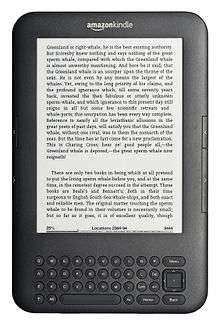
Kindle Direct Publishing or KDP is Amazon's e-book publishing unit which was launched when the company began selling its Amazon Kindle book reading device in 2007.[18] Books can be published in numerous languages.[44] Amazon's KDP has hundreds of thousands of self-published titles.[21] Amazon's KDP program uses ASIN identifiers instead of ISBNs to identify e-books.[45] Amazon does not release sales figures of its authors.[13] Many authors prefer Amazon for its global clout and reach.[9] One analysis suggested that Amazon earned $2.3 billion from e-book revenues in 2016, and 25% of these were from self-published e-books; and Amazon released 4 million e-book titles in 2016, and 40% of them were self-published.[1] Another estimate was that Amazon controls 70% of the e-book market.[46]
Amazon's Kindle Unlimited service lets readers read any books in its catalog, provided that the users pay a monthly fee. Amazon tracks which books are selected and read by subscribers. An author who wants to have their book included in this program enters into Amazon's KDP Select program, and as part of the agreement, the author promises to make their book exclusive to Amazon. The author can opt out of the KDP program every ninety days. An estimate in 2017 was that of Amazon's Kindle Unlimited market, about 60% of the books read and borrowed were self-published.[46] Amazon initially began the program by paying authors whenever their book was chosen, but then it switched to an arrangement in which it pays authors based on pages read. Each month, Amazon establishes a fund from which to pay authors, based on Amazon's accounting of which pages are read. Amazon has been criticized for short-changing authors by paying them out of this monthly fund.[29] As a result of the program, many Amazon authors found that their income decreased substantially when the company switched to the pages-read basis.[29] The collective fund for KDP authors in August 2017 was $19.4 million which was the "largest ever" of the monthly funds, but overall authors received the lowest amount, which was $0.00419 per page for that month.[29][47] Some authors tried to compensate for less income by slightly altering and republishing their work, to try to increase the total of pages read.[29] The change to the pages-read model was criticized as being a "huge pay cut" for authors.[48] None of the big 5 publishers contributed books to Kindle Unlimited as of 2017.[48]
IngramSpark
IngramSpark lets authors publish digital and paperback editions of their books. It distributes books to most online bookstores. Brick-and-mortar stores can also order books from IngramSpark at wholesales prices for sale in their own venues. It is run by Ingram Content Group.
Apple
Apple sells books via its App Store which is a digital distribution platform for its mobile apps on its iOS operating system. Apps can be downloaded to its devices such as the iPhone, the iPod Touch handheld computer, and the iPad. Apple pays authors 70% of its proceeds at its Apple iBookstore where it sells iBooks.[4]
Smashwords
Smashwords is a California-based company founded by Mark Coker which allows authors and independent publishers to upload their manuscripts electronically to the Smashwords service, which then converts them into multiple e-book formats which can be read on various devices. Authors control what price is set.[44]
Barnes & Noble
Barnes & Noble pays 65% of the list price of e-books purchased through its online store called Pubit.[4][44]
Kobo
Kobo is a Canadian company which sells e-books, audiobooks, e-readers and tablet computers which originated as a cloud e-reading service.[4]
Scribd
Scribd is an open publishing platform which features a digital library, an e-book and audiobook subscription service.[4] It began as an online sharing site for books, and evolved into a store; books published there entitle an author to 80% of the sales price.[4]
Lulu
Lulu is an online print-on-demand, self-publishing and distribution platform.[44]
Print-on-Demand
Print-on-demand (or POD) publishing refers to the ability to print high-quality books as needed. This is usually the most economical option for self-publishers who expect sales to be sporadic over time. An alternative is to hire a printing press to do a print run in which a large number of books are printed at one time, such as a hundred or a thousand copies, which can result in a slightly lower per-book printing cost, but risks holding onto unsold inventory for an extended period of time. Print-on-demand means that a book is printed only after it is purchased, lessening the risk, which eliminates the need for expensive warehouse space.[4] Many companies allow single books to be printed at per-book costs which are not much higher than those paid by publishing companies for large print runs.[49][18] Ingram is the largest book distributor, and it can help self-published authors get access to 39,000 bookstores, according to one report.[1] The physical quality of print-on-demand self-published books is generally the same as that from an established publisher, although quality can in some instances vary.[18]
E-books
.jpg)
Generally self-publishing works best with e-books because, unlike print-on-demand self-publishing, it solves the twin problems of price and distribution.[18] There are a variety of e-book formats and tools that can be used to create them. Because it is possible to create e-books with no up-front or per-book costs, this is a popular option for self-publishers.[50] [50][9] When a person buys an E-book, the buyer does not own the book, but owns a license only to read the book.[34] Formatting standards for e-books continue to evolve; at present, there have been compatibility problems with some digital e-book readers. For example, a recent EPUB 3.1 e-book format is not compatible with earlier e-book readers such as the Kindle.[34] E-book formats include EPUB, MOBI and PDF, among others. In 2017, there was a report in the Chicago Tribune that e-books sales are continuing to increase.[34] Epublishing distributors allow an author to sell on multiple platforms, often providing conversion and formatting services, usually charge no fees upfront, and make money by taking a small percentage of each book sold.[18]
Vanity press
Users pay to have their books published. While a commercial publisher's market is the book-buying public at large, the vanity publisher's market is the author himself or herself. Some authors buy substantial copies of their own book which are then used as giveaways or promotional tools. The term vanity press is considered pejorative since it suggests that a person who hires such a service is unqualified or unable to have their book succeed in the market, and that the author is printing the book only out of vanity. In this business model, there can be elements of fraud, such that some vanity presses masquerade as legitimate publishers, and pretend to be selective and choosy in their book selections, and prey upon a would-be author's desire to be published. If a vanity press charges a higher amount to print a run of books than a regular printer, it can be an indication of deception and fraud.
Kindle Direct Publishing
CreateSpace was Amazon's print-on-demand book publishing service. Authors could sign up for an account, and the online software guided an author through the steps of publication, such as uploading a cover, selecting distribution channels and setting prices.[4] Books uploaded to CreateSpace became part of Amazon's online catalog and were made available to book buyers around the world. Amazon collected revenues from book sales on behalf of authors, and then deposited royalty monies directly into an author's account, usually after a few months or so after the sale.[9] CreateSpace offered additional services to help authors, such as cover design and copyediting ($120+) as well as converting the manuscript file to a Kindle-compatible e-book file ($70).[4] CreateSpace offered authors free book identifying numbers or ISBNs without extra charge, or authors could buy their own ISBN numbers. In August 2018 CreateSpace was absorbed into Amazon's Kindle Direct Publishing (KDP).
Smashwords
Smashwords publishes and distributes e-books.[9] Smashwords authors keep 60% of the sale price, and Smashwords keeps 10%, and the retailer keeps 30%; if a sale is made directly through Smashwords, the author keeps 85% of the sales price.[4] Smashwords provides a list of freelance assistance services.[4] In 2017, it distributed 250,000 titles for 60,000 authors to most of the world's e-book stores in exchange for a cut of the author's profits.[21] Smashwords books can go on sale a few minutes after they're uploaded.[48]
I believe every writer is great and wonderful and has something to share with the world. Readers will decide if what they're sharing is worth reading.
— Mark Coker of Smashwords, 2013 [2]
Lulu
Lulu publishes print and e-books and offers publishing-related services such as website design, cover design, editing packages, and strategies for social media promotions.[9] It was founded in 2002.[9] Lulu charges nothing upfront, and each time a book is sold, it keeps 20% of the profit and pays 80% to the author.[4] Lulu offers additional services such as editing ($450) and cover design ($130) and other services such as design and formatting which can cost from $700 to $5000.[4] Lulu enables authors to print books not only in paperback form, but in hardcover and comic book forms as well.
Author Solutions
Author Solutions sells services such as editing, e-book production and marketing services. According to one report, it served 170,000 authors who wrote 200,000 titles as of 2017.[21][51] Penguin Random House, a mainstream publisher, once bought, then sold, Author Solutions.[52]
FastPencil
FastPencil sells editing services, as well as consulting services related to publishing and distribution, for a fee.[21]
Reedsy
Reedsy is a British online author services firm which connects authors and freelance professionals.[53][54][55] It has a network of vetted editors, cover designers, illustrators and book marketers and takes a 10% cut of each contract between author and freelancer.[1] In addition, it offers online software tools to help authors convert files for publication in print and in e-book form, and offers training courses by email to help authors navigate the self-publishing process.[56] The firm checks the credentials of publishing freelancers such as story editors, cover designers, marketers and others, by verifying their previous work experience for mainstream publishers as well as their overall track record in the publishing industry.[57] Reedsy checks the credentials of writing contests as well to help writers avoid wasting time with fake contests and prizes.[58] In addition, it offers online software tools to help authors convert their manuscript files to files suitable for publishing e-books, such as EPUB and PDF formats,[57] as well as learning programs to help authors navigate the self-publishing process.[59] In 2016, the Reedsy community included 20,000 authors and 500 freelancers, and had helped them publish 3,000 books.[60] Reedsy began in 2014 after being funded by Seedcamp,[61] founded by Emmanuel Nataf, Richard Fayet, Matthew Cobb and Vincent Durand.[61] While the start-up firm is headquartered in London,[61] it is a "completely officeless business" such that its staff is physically distributed in different locations, and conducts business via cloud computing.[62]
Matador
Matador is the self-publishing imprint of Troubador Publishing Ltd, a traditional publishing company based in Leicester, United Kingdom.[63] In the last 19 years Matador has published over 5000 titles in book and ebook formats, approximately 500 titles a year. The company not only has print 'on demand' distribution, but sales representation by Star Book Sales and distribution to retailers via Orca Distribution. It published Louise Walters second novel, A Life Between Us, in 2017,[63] as well as Polly Courtney's Golden Handcuffs and Ben Hunt-Davis' Will It Make the Boat Go Faster,[64] which sold over 40,000 copies.
Other services
There are a variety of freelance professionals available through the Internet who can assist with a wide variety of publishing-related tasks.
The self-publishing market
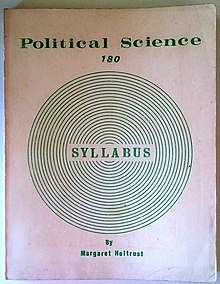
- Overall publishing market is expanding. Since 2000, there has been an increase in the sales of digital titles, audiobooks, self-published paperbacks,[65] including printed as well as e-books. The overall market for all books, including from traditional publishers, is growing as well.
- Explosive growth of new titles. The growth in new titles has been strong, particularly in the past decade. In 2002, there were a quarter million new titles, but since 2009, the number of new titles has topped 1.3 million each year.[48] In 2010, according to a different analysis, there were 4.2 million new titles published.[48] Much of the growth in new titles has been because of self-publishing. In 2011, self-published books made up 43% of all print titles, helping to increase overall growth of print production, according to Bowker market research.[66] In the middle of the second decade, the growth of print titles seemed to ebb somewhat, perhaps eclipsed by the growth of e-book titles. For instance, from 2014 to 2015, print titles grew by 34%; from 2015 to 2016, print titles grew but more slowly by 11%.[67] That is the growth of new titles; book sales increased as well, growing by 3% in 2016.[68] In 2017, there were reports that sales of physical books were increasing in the United States.[65]
- Strong growth in self-publishing. There has been a "dizzying rise in self-publishing," according to one view.[48] Self-published book titles in production tripled from 2006 to 2012.[66] 2008 was a watershed year; for the first time in history, more books were self-published than those published traditionally.[69] In 2009, 76% of all books released were self-published, while publishing houses reduced the number of books they produced.[70] Back in 2008, there were 85,468 self-published titles;[71] in 2011, 247,210; by 2012, 459,000; by 2013, 458,564;[71][19] by 2017, 786,935 self-published ISBNs.[67][48][21] During a period of six years, growth of self-published titles was a remarkable 218%.[67][48] These numbers don't count titles published by Amazon's KDP which identifies books by ASIN numbers instead of ISBN numbers. These are worldwide figures, but the numbers are strong for particular markets as well; for example, in the United Kingdom, readers bought 18 million self-published books in 2013, a 79% increase from the year before.[72] The numbers are strong for particular platforms too; for instance, in 2012, of books sold by Amazon's Kindle KDP service, a quarter of those sales were self-published.[72]
- A saturated market of mostly junky titles. The self-publishing ecosystem has become flooded with titles.[17] While self-publishing overall is booming, most new titles are poorly written or confused or otherwise lacking in appeal. There are a few dozen self-published books that are winning most of the sales, so for the others, even quality self-published books seeking to get attention, it is increasingly difficult to be noticed. Of profits paid to authors by Smashwords, the best-selling 1% of titles earn half of all sales money.[21] Some authors earn modest profits from their work. For example, writer Wayne Hicks of Arkansas published five titles, spending $700 on editing and marketing services, and spent a thousand hours creating and promoting his books; he's sold a thousand copies for a profit of $1,400.[21]
The largest, by far, percentage of authors are making less than $500 a year self-publishing, because there's a glut. There's over 350,000 books being self-published every year and readers are not finding them. There's just no way to expose people to all of these books.
— Novelist M.J. Rose in 2012[44]
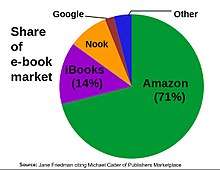
- E-books expanding. E-books are a relatively new technology, and growth in the number of e-book titles as well as sales have been strong since the middle of the first decade. In 2011 and 2012 the size of the market, in terms of trade publisher e-book revenues, was $2 billion, about 16% of the total trade industry.[44] Monthly e-book sales increased 49% from 2011 to 2012.[44] On another measure, based on statistics from Smashwords, the service had only 140 e-books published in 2008; by 2016, it had published 98,000 e-books. In another measure, from the six-year period from 2011 to 2017, e-book sales on Smashwords tripled.[2] In the e-book market on Amazon, self-published titles were estimated at about 40% of unit sales, while e-books by traditional publishers captured about 80% of total dollars, because of higher prices.[46] Several reports indicated that e-book readership and sales among major publishers had "hit a speed bump" around the middle of the second decade, from the years 2014 to 2016.[34][68][65] A 2017 survey of 1200 publishing companies found that the market for e-books had declined from 22% to 18%, although the survey did not count self-published e-books or books published through a single retailer such as Amazon.[34] From 2015 to 2016, e-books declined in terms of title registrations by −3%.[67] Most likely the decrease was the result of major publishing companies raising the prices of e-books on average from $6 to $10, which had the effect of dampening demand.[34] The "Big 5" traditional publishers include Hachette, HarperCollins, Macmillan, Simon & Schuster, and Penguin Random House. These firms have 37% of the overall book market in 2017, but only 26% of the E-book market.[34][32] Hachette CEO Michael Pietsch said that one of the reasons for an e-book slowdown was that readers continue to love the physical form of printed books, and that the physical book format is "hard to improve on".[32] However e-books as a format offer numerous benefits, such as the ability to resize text, to click on a word to learn its definition, to scroll, to hunt for specific words, and so forth, that it is likely that e-books will continue to become more popular.

- Traditional publishing is losing share. There are major shifts in the publishing market as a whole, with sales by "indie publishers", which includes self-publishers, surpassing the "big five" which includes Hachette, HarperCollins, Macmillan, Simon & Schuster, and Penguin Random House.[34]
- More crossover activity. As self-publishing loses its stigma and its benefits via technology become more apparent, there are more instances in which new authors choose self-publishing as their primary route,[71] as well as established authors leaving traditional publishers and self-publishing their titles. There are greater instances of self-published authors selling their books in major retailers such as Barnes & Noble, Target, and Walmart.[17]
- Rapid growth in all-you-can-read subscriptions.[48]
- Proliferation of devices which can read e-books. These include smartphones and tablets and laptop computers. As a corollary, the number of people using single-purpose dedicated e-book reading devices, such as Amazon Kindles, declined from 30% of all adults in 2013 to 19% in 2015.[34]
- Prices being pushed down. Digital piracy, proliferation of titles, and lower-priced e-books means that there is downward pressure on prices affecting the entire publishing industry, although the market as a whole is growing.
- Changing patterns of readership. There are some people who don't buy or read books, and a few studies suggest that the buying of books as well as readership are declining for some people. In 2010, according to one report, 9% of Americans didn't read a book, and this increased to 16% for 2013.[48] The same report chronicled a decline in the percentage of American book buyers, from 21% who didn't buy a book in 2010, to 35% who didn't buy one in 2013.[48][68] In 2016, 72% had never read an e-book.[68] A study in 2017 found that students were better able to assimilate information when it was read from printed textbooks, rather than online, although reading online was usually faster than print, and students thought, mistakenly, that they learned better by reading online.[73]
- Self-publishing is dominated by Amazon. Amazon commanded 70% of the self-publishing market in 2014.[14][67] There are competitors such as Smashwords and others but the lion's share of the market is owned by Amazon. An estimate in 2017 was that Amazon had four million books for sale in its Kindle store.[17] A report concluded that amazon is the big leader in the e-book and e-book reader market, owning 80% of the English-language market.[34] Amazon has not gotten along with traditional bookstores, many of whom refuse to stock Amazon titles.[35]
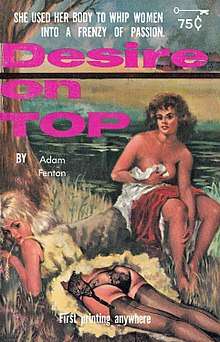
- Self-publishing seems better suited for certain genres. Genres that do well for self-publishing include romance, erotica, mysteries, thrillers, and science fiction, in the sense that self-published books in these genres tend to have a more favorable chance of finding success.[3][48][14][74] A survey in 2014 found that self-publishers made the most money in the genres of romance and science fiction/fantasy.[18] In the past, traditional publishers underestimated the market for erotica in which many self-publishers have focused.[32] Alisha Rai's erotic novel Serving Pleasures, published through CreateSpace, appeared on the bestseller list of the Washington Post.[3] Genres which do not do well for self-publishers include cookbooks, nonfiction and academic publishing.[48] Generally academics have steered clear of self-publishing, as the market is dominated by university presses and academic journals which publish slowly, don't pay much, and subject content to strict peer reviews.[72] There are reports that some scholars are frustrated with the state of academic publishing, and while most still choose the traditional publishing route, there are some who have chosen to start their own journals or independent presses, or who have expanded into blogging.[72]
Promoting a self-published book
There is wide consensus that since the market is flooded with titles, the most difficult task facing self-published authors is attracting attention to their book.[4] Some authors have tried unconventional methods to cut through the clutter. For example, self-published author James Altucher offers to pay readers if they can prove they bought and read his book; he explained that people are more likely to value what they pay for, and this offer entices them to actually read his book.[40] While he takes a small loss each time a reader accepts his offer, overall he feels it promotes sales.[40] Experimentation helps. One strategist suggested that an author should have a creative marketing campaign and try one tactic each day, while studying those tactics undertaken by successful self-publishers.[4] One author spends roughly $70,000 annually creating and promoting her books, and hires a dozen freelancers for various parts of her operation.[21] Another self-published author gave 80 books to friends, who told their friends, to generate positive publicity.[14] A strategy that helps many self-published authors is to write a series, making the first installment free, and charging for subsequent versions.[18]
Authors have tried numerous approaches to promoting and marketing their books, including...
- Building a web presence[75]
- Building a mailing list[75]
- Promoting e-books through targeted giveaways[75]
- Offering a limited edition print book[11]
- Promoting books through social media[21]
- Writing a blog[21][14]
- Having an author website[14]
- Raising funds for advertising through crowdfunding[48]
- Having book signings[14]
- Going to craft fairs[14]
- Hiring a public relations firm[14]
- Generating positive word of mouth[14]
- Joining a self-publishing group[39]
- Adding an audio book[19]
- Becoming an indie publisher[19]
- Entering contests open to self-published authors
- Donating paperback copies to libraries[19]
- Getting books into local bookstores[19]
Most book contests are open only to books published by established publishers, but there are a few contests open to self-published writers. One is the Illinois Library Association, in conjunction with BiblioBoards and with Reaching Across Illinois Library System, which sponsored a prize for best self-published novel; the contest is open to Illinois-based self-published writers.[76][77] The British newspaper The Guardian, in conjunction with selected publishers, has a Self published book of the month award, which began in 2014; entries are submitted digitally and must be in the English language, and the contest is open only to residents of the United Kingdom.[78]
Who is self-publishing?
Self-publishers include a wide variety of persons. Some retirees are self-publishing the story of their life, to leave as a legacy to their offspring after they're gone.[79] Sometimes adults help write and edit the book for their parent; for example, Arthur Chiang helped his mother describe her life as an immigrant, adding photos, and helping with the technical aspects of preparing the manuscript for publication.[79] There have been instances in which parents, to give their teenaged children experience with writing and to involve them in fun projects, acted as "publishers" for their children, paying some of the costs to have their offspring self-published.[80] Eleven-year-old John Ruskin sold a book of poetry he self-published with his father.[6] Author Brooks Olsen chose Amazon after writing her self-published book, which was edited in part by her parents, with a cover design from her boyfriend, saying she liked having Amazon's clout behind her.[9] The motivations of self-published writers are many, and include building a career as a writer and satisfying an ambition, along with money, which isn't usually the top reason.[21]
Self-publishing success stories
.jpg)
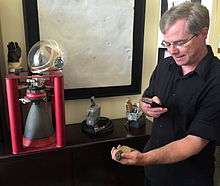
While almost all self-published books do not make much money, there are dozens of self-published books that have broken through to huge audiences and success, and which get much media attention.[9][13] The number of authors who have sold more than one million e-books on Amazon from 2011 to 2016 was 40, according to one estimate.[17]
- Fifty Shades of Grey by E.L. James was originally published online as Twilight fan-fiction before the author decided to self-publish it as an e-book and print on demand.[7][4][14]
- The science fiction novel The Martian, by Andy Weir, was originally released as chapters on his personal blog, and then self-published as an eBook in 2011.[16] The rights were purchased by Crown Publishing which re-released it in 2014; the novel went on to become a bestseller and then a major motion picture starring Matt Damon.[81][16][82][83]
- Blogger Alan Sepinwall's self-published book The Revolution Was Televised became an instant hit, winning a prominent review within two weeks of publication by critic Michiko Kakutani in the New York Times.[9] Sepinwall hired an editor and spent roughly $2,500 on services to get his book ready for publication.[9]
- Minnesota social worker Amanda Hocking uploaded several books in 2010 and sold a few dozen copies. She published several more manuscripts and within a few months was making enough money to quit her daytime job.[21] She later won a deal with Macmillan publishers, and went to being a millionaire in a year.[21] She sold her series to St. Martin's Press in 2011 for two million dollars.[17]
- Swedish author Carl-Johan Forssen Ehrlin wrote a book in 2010 which helped get children to go to sleep; his The Rabbit Who Wants to Fall Asleep title featured amateurish illustrations with "clunky prose" and a monotonous storyline, but parents bought it for the catchy subtitle of "A new way of getting children to sleep".[84] He released it on CreateSpace and it became a bestseller.[84]
- Erotic romance author Meredith Wild sold 1.4 million digital and print copies of her books, and founded her own publishing company called Waterhouse Press; she founded the firm in part because she felt that her novels were "not being taken seriously" as an indie author.[17] An advantage of having her own imprint is that it is easier to get books into chainstores and big-box retailers.[17]

- The breakout hit Wool by Hugh Howey was self-published originally and garnered more than a million dollars in royalty monies, and has generated over 5000 Amazon reviews.[85][86]
- James Altucher's Choose Yourself (2013) sold 44,294 copies in its first month, debuted at No. 1 on Amazon's top non-fiction list, and was a Wall Street Journal bestseller.[87]
- Victoria Knowles achieved notoriety in July 2014 when her self-published book The PA reached the number one spot in the iTunes chart for paid books.[88]
- Matthew Reilly's self-published Contest, the first of his action-thriller novels, in 1996.[89]
| Title | Author | Notes |
|---|---|---|
| Golden Handcuffs[90] | Courtney, Polly | |
| The Celestine Prophecy[90] | Redfield, James | |
| Shadowmancer[90] | Taylor, G. P. | Later published by Faber & Faber |
| The Shack | Young, William P. | First million copies published by Windblown Media; subsequently on The New York Times best seller list.[91][92]> |
Traditional versus self-publishing
Traditional publishers can offer editorial guidance, marketing muscle, and access to well-established channels of distribution, and have been the preferred choice for writers for the past century.[17] Still, there are increasing advantages for self-publishing, and there are increasing instances of writers moving between both the traditional and self-publishing models, for various reasons. Self-publishing is an increasingly likely choice for authors who are "midcareer, midlist, middle-aged, more or less middlebrow, and somewhat Internet savvy," writes journalist Neal Pollack, who extols the promise of being able to reach readers directly.[12] Elizabeth Prybylski, publisher of Insomnia, an indie press, describes the main difference between self-publishing and traditional publishing is "who puts up the overhead of production."
If the author doesn't have the money, time, or inclination to do all of those things for their book and to pay the costs of production, a publisher's experience and knowledge can make up for that gap.
— Elizabeth Prybylski of Insomnia Press.
Analyses have been made suggesting that self-published authors' earnings have been comparing favorably to earnings from established publishers,[13] and this may be a factor causing established authors to switch to the self-publishing approach. While a self-published author can typically keep 70% of the sales price, a typical contract with a publisher will be payment of an advance sum such as $5000 to $10,000, plus receiving 25% of digital sales and 7% to 12% of the list price for bound books, which the author will receive after the publisher recoups the money paid for the advance to the author.[93]
Authors being published the traditional way have seen their income from publishing decline in recent years. A survey from the Authors Guild found that authors with contracts with established publishers were making 30% less money in 2015 than they had been making in 2009.[94] Talented writers in traditional publishing, who have won prizes and awards, are earning less, with some living at or near the poverty line.[94] Some books sell only 5,000 to 20,000 copies, some less than that.[94] Factors identified as dampening the income levels of such authors include the online piracy of digital material, major publishing houses consolidating to focus more on profits, and the rise of Amazon and self-publishing.[94]

Some writers have been dissatisfied with the marketing efforts of a traditional publisher. One writer got fed up when the publisher made basic mistakes with a book launch, and so he "decided to take his book back" and self-published it. He hired the firm Reedsy to redesign his book The Pink Marine, and went on to form his own imprint.[8] Novelist Louise Walters felt that traditional publishers were "debut-centric" and obsessed with celebrities.[95] David Mamet, whose book The Secret Knowledge: On the Dismantling of American Culture had been on the New York Times bestseller list, chose to release his novella by self-publishing.[93] He had been dissatisfied with the marketing efforts of his traditional publisher.[93] There was a report that suggested that traditional publishers have lessened their marketing efforts on behalf of authors.[93] Another example is romance novelist Courtney Milan who switched to self-publishing because she wanted to have "more agency over the background of her characters" and her stories.[23] Some photographers, who felt hemmed in by the traditional photo book publishing world, have started up their own imprints as a way to publish their own books.[11] Writer Sarah Grimm moved away from the traditional publishing approach to self-publishing because she wanted greater control over cover design, publication dates and the story content.[39]
My first book went through so many different changes that when it released, I no longer felt like it was the story I originally set out to tell.
— Author Sarah Grimm on why she chose self-publishing.[39]
Novelist Louise Walters explained why she switched to the self-publishing mode, after her publisher rejected her second novel, describing self-publishing as an "exhilarating change":[95]
Footing the bill to bring out the book means the responsibility is on my shoulders, but at the same time it's incredibly freeing. I can market this book in any way I choose; I have real input into every decision regarding my work; I'll even earn a fairer share of the proceeds from each sale … It's only a book, after all, and self-publishing is a whole lot of fun.
— Louise Walters in 2014[95]
Still, it is likely that when a self-published author creates a bestseller, that he or she will accept an offer from a major publisher. Some traditional publishers troll the lists of bestselling self-published titles to look for new books to sell.[2] Smashwords president Mark Coker predicted that it will become more difficult for traditional publishers to entice the best self-published authors, simply because traditional publishers don't pay as much.[2] Successful self-published authors have been courted by literary agents and publishers offering substantial sums of money.[17] It's getting harder for established publishers to woo away successful self-published authors since the royalty structure they offer may not match the profits to be made from publishing on their own.[17]
Advantages of self-publishing
Benefits include:
- Speed. An author finds out right away whether a book is a hit with readers; there is not a six-month or longer delay typical with an established publisher since the usual back-and-forth steps with a publisher are bypassed. It is possible to release a book within a few weeks after it is finished.[39] Further, it is possible to avoid the lengthy process of trying to find a literary agent to secure a publishing contract.[71]
- No start-up costs. Manuscripts uploaded to KDP or Smashwords typically do not incur any fees.
- Freedom to begin the next book. An author can self-publish and then begin work on the next project, potentially being more prolific, although this presumes that the first book won't need any marketing effort.
- A greater share of royalties. Self-published authors earn four to five times more per unit than if an author works with a traditional publisher,[2] sometimes 70% of the sale price.
- Pitch books straight to the readers. There is no intermediary censoring what might be shown to the public. The route to readers is more direct.
Authors are no longer bound in their storytelling by what the traditional publishers think the market can bear ... Instead, because we can go straight to the reader now, we can write exactly the books that we want to write and exactly the books that our fans want to read. We don't have to worry about whether an agent can sell the book, or if an editor and publisher want to buy the book, or if a retailer wants to stock the book. Personally, I think this new open market can – and does – make for much more interesting storytelling.
- Creative freedom.[71]
With self-publishing you don't waste your time trying to get published, which can take years of query letters and agenting, and all this stuff. You go straight to the real gatekeepers, which are the readers. If they respond favorably and you have sales, you can leverage that into a writing career. If they don't, you write the next thing. Either way you're not spending your time trying to get published, you're spending your time writing the next work.
Disadvantages of self-publishing
There are significant challenges to self-publishing as well.
- Most self-published books sell few copies. Some estimates are that they sell fewer than 100 to 150 copies;[4] another estimate is that most sell fewer than 250 copies.[18] However, the vast majority of books promoted by traditional publishers fail as well.[48] Still, the overwhelming odds are that any self-published book will be ignored and end up in the "digital slush pile."[12]
- Crowded landscape. There is much competition and it is difficult to get one's book to be noticed in a glutted market.[19] Big publishers have much better prospects for getting attention for a book.[32]
- Lack of prestige. A book from a traditional publisher still has a lot of cachet in that it has been vetted by editors, which gives it a "stamp of approval."[71][14]
- Hard to get into bookstores. Big bookstores rarely take self-published books, and if they do, they want 50% of the sales price.[14] Publishers have established distribution channels to make this easy.
- Publishers offer editorial and marketing help. Plus they usually pay an advance to help the author with expenses at the early start of the publishing cycle, an advantage which self-published writers do not have.[14]
You risk looking like an amateur ... Good writers need even better editors. They need brilliant cover designers. They need imaginative marketers and well-connected publicists. All these things are provided by a traditional publisher, and what's more, it doesn't cost you a penny. They pay you! If a self-published author wants to avoid looking like an amateur, they'd better be prepared to shell out some serious cash to get professional help in all the areas where they don't excel. And I mean serious.
— Ros Barber in 2016.[96]
- Difficulty getting reviews in the mainstream press. It is difficult for self-published books to be reviewed in newspapers and magazines. The media favors books from traditional publishers before giving reviews.[14][96]
- Hiring editors, proofreaders and cover designers can be difficult and expensive.
- Authors must spend much time marketing their books. Authors must work hard to market their books, which is a task that many authors are not skilled at or willing to do.[17]
- Having to spend time marketing the book. One self-published author in Britain was working "14-hour days", spending months promoting her book Only the Innocent; while she eventually made it to the UK Kindle bestseller chart, Rachel Abbott still has difficulty getting the publishing world to take her book seriously.[97] Another writer, Ros Barber, thinks self-publishing is a "terrible idea for serious novelists" since the requirements of marketing and promoting a book will prevent one from writing, and he continues to recommend the traditional approach.[96]
You have to forget writing for a living ... Self-publishing can make you behave like a fool ... The vast majority of indie authors have tweetstreams that are 90% adverts, perhaps a reflection of the fact that they must spend 90% of their time marketing ... Good writers become good because they undertake an apprenticeship.
— Ros Barber on the benefits of the traditional approach, 2016.[96]
- Self-published books usually ineligible for prizes. Books are not eligible for major prizes such as the Hay festival, the Booker, the Baileys, the Costa and the Man Booker, and literary novels need these prizes to become a bestseller.[96] However, there are signs that this is changing as more books become self-published.
See also
- Alternative media
- Dōjin
- List of self-publishing companies
- Independent music
- Samizdat
- Self Publish, Be Happy
- Category:Self-published books
- Small press
- Predatory open access publishing
- Author mill
- Vanity publishing
References
- Jennifer Alsever, Fortune magazine, 30 December 2016, The Kindle Effect, Retrieved 9 November 2017, "...has become a $1 billion industry..."
- All Things Considered; Robert Siegel (host); Audie Cornish (host) (4 February 2013). "Self-Publishing Now The First Choice For Some Writers". NPR. Retrieved 20 October 2017.
"....survey found that the number of self-published books in the U.S. has almost tripled in the past six years….
CS1 maint: multiple names: authors list (link) - Ron Charles (26 November 2015). "Romance finally breaks The Post's 'No Self-Published Books' rule". WashPost. Retrieved 20 October 2017.
".... I think this new open market can – and does – make for much more interesting storytelling….
- Alan Finder (15 August 2012). "The Joys and Hazards of Self-Publishing on the Web". The New York Times. Retrieved 20 October 2017.
... "The biggest thing you have against you in trying to sell your book is that people don't know about it," he said….
- Husna Haq (15 October 2013). "Kobo removes all self-published titles. Is this censorship, an overreaction, or just good sense?". CSM. Retrieved 20 October 2017.
"...Retailers including Amazon, Barnes & Noble, the UK's WH Smith, and Canada's Kobo have removed problematic self-published titles after the discovery of a slew of pornographic abuse-themed e-books...
- Patterson, Christina (18 August 2012). "How the great writers published themselves". The Independent. London. Retrieved 17 August 2012.
- Balson, Ronald H. (8 October 2013). "Bestseller Success Stories that Started Out as Self-Published Books". The Huffington Post. Retrieved 22 July 2015.
In 1931, Irma Rombauer wrote "The Joy of Cooking," with her daughter… .
- Karen Angel (26 May 2016). "It's a Writer's Market: Digital platforms have emerged to serve midlist authors". Bloomberg. Retrieved 20 October 2017.
...or Greg White … "Five years ago, self-publishing was a scar," White says. "Now it's a tattoo."...
- LYNN NEARY (19 December 2012). "Self-Publishing: No Longer Just A Vanity Project". NPR. Retrieved 20 October 2017.
...They used to call it the "vanity press," and the phrase itself spoke volumes….
- PC Magazine, Eric Griffith, 1 October 2012, How To Self-Publish Your Novel on the Amazon Kindle, Retrieved 25 October 2017, "..Paying to get published, though, breaks Yog's Law, which states, "Money should flow toward the author."..."
- Laurence Butet-Roch (4 December 2014). "When Photographers Become Self-Publishing Companies: An increasing number of photographers are bypassing traditional photo book publishers, setting up, instead, their own imprints". Time magazine. Retrieved 20 October 2017.
"... Investing in a project shows that you believe in it....
- NEAL POLLACK (20 May 2011). "The Case for Self-Publishing". NYT. Retrieved 20 October 2017.
... midcareer, midlist, middle-aged, more or less middlebrow, and somewhat Internet savvy – self-publishing seems to make a lot of sense … why not start appealing directly to those readers?...
- Steve Henn (25 July 2014). "Self-Published Authors Make A Living – And Sometimes A Fortune". NPR. Retrieved 20 October 2017.
...Five years ago, printing your own book was stigmatized and was seen as a mark of failure...
- "Self-publishing vs. traditional publishing: How to choose?". Miami Herald. 16 November 2014. Retrieved 20 October 2017.
...Big bookstores will not always take you if you are a self-publisher...
- Ron Charles (1 October 2014). "No, I don't want to read your self-published book". Washington Post. Retrieved 20 October 2017.
......1. There are too many of you....
- "The surprising story of how Andy Weir's self-published book The Martian topped best seller lists and got a movie deal". Businessinsider.com. Retrieved 28 January 2017.
- ALEXANDRA ALTER (30 January 2016). "Meredith Wild, a Self-Publisher Making an Imprint". NYT. Retrieved 20 October 2017.
...the ones who are very successful at it are making a lot of money, which … can be hard to match with the traditional publishing royalty structure...
- Science Fiction and Fantasy Writers of America, Self publishing, Retrieved 5 November 2017
- Alex Daniel (20 January 2017). "Self-Publishing in 2017: The Year in Preview: New opportunities and challenges await self-publishing in the coming year". Publishers Weekly. Retrieved 20 October 2017.
...Self-publishing continues to expand, with ISBN registrations jumping 21% from 2014 to 2015 …
- "Writers embrace self-publishing through instant publishing machine". The Oregonian. Associated Press. 11 June 2012. Retrieved 20 October 2017.
...the Espresso Book Machine by on Demand Books debuted in 2006...
- Jeremy Greenfield (29 November 2013). "Companies book profits from self-publishing". USA Today. Retrieved 20 October 2017.
… According to Smashwords … the best-selling 1% of titles net half the sales….
- Bruno Ceschel (21 September 2015). "A Manifesto to Self-Publishing Your Own Photobooks". Time magazine. Retrieved 20 October 2017.
..."The act of self publishing has a longstanding roots, from the very beginning of the history of book making," adds Ceschel. "It has always been an act of defiance against oppression (religious, political, economic, sexual, etc). DIY culture is, by its nature, an ethic in opposition to society's rules at large. It flourishes in environments of communitarian support, collaboration, and even informal barter economies."...
- KATHERINE ROSMAN (10 October 2017). "In Love With Romance Novels, but Not Their Lack of Diversity". The New York Times. Retrieved 20 October 2017.
... best-selling romance author who has turned to self-publishing in order to have more agency over the background of her characters … systemic problem in that publishing is insular … nobody understood … that people of color have inner lives …
- Jennifer K. Bauer (12 October 2017). "Publishing? Glad tidings: Aspiring writers, take note: Library is holding Indie Author Day". Lewiston Tribune. Retrieved 20 October 2017.
.. free self-publishing platform called Self-e, a collaboration between Library Journal and BiblioBoard …. more of a marketing tool.
- Hector Tobar (21 October 2013). "Self-published e-books rife with illicit erotica, survey finds". Los Angeles Times. Retrieved 20 October 2017.
... new survey shows that self-published e-books contain more extreme sexual content than their traditionally published counterparts..
- Carolyn Kellogg (9 August 2013). "Florida slaying suspect Derek Medina's awful self-published books". Los Angeles Times. Retrieved 20 October 2017.
....The man who allegedly posted a photo of his dead wife … Medina … charged with murder … his slew of self-help books is all the more disturbing...
- Laura Bennett (1 May 2015). "Kim Kardashian just wants to be seen. This 445-page book of selfies might be her masterpiece". Slate magazine. Retrieved 20 October 2017.
...This book consists entirely of selfies. That's 445 pages of them, arranged chronologically … no literary ambitions at all….
- Marissa Martinelli (6 June 2017). "Milo Yiannopoulos' Self-Published Book Is an Amazon Best-Seller. So Much for Free-Speech Martyrdom". Slate magazine. Retrieved 20 October 2017.
... While Simon & Schuster had previously defended the decision to publish Yiannopoulos' book … the publisher finally dropped the British provocateur...
- Thu-Huong Ha (20 September 2017). "Amazon has laid out exactly how to game its self-publishing platform". Quartz media. Retrieved 20 October 2017.
… Amazon established its collective fund for self-published books, last month's US pot, at $19.4 million, … authors got the second lowest payout ever ... at $0.00419 per page read...
- The Atlantic, Joy Lanzendorfer, 6 June 2016, Stealing Books in the Age of Self-Publishing: Many authors who sell their work directly on platforms like Amazon are having their stories plagiarized, which can take an emotional and financial toll., Retrieved 31 October 2017, "...Rachel Ann Nunes ... First published in 1998, A Bid for Love did well enough to spawn two sequels ... Mullens' book, titled The Auction Deal, looked like the same story with much of the same language..."
- Chloe Smith (4 January 2017). "Top Ten Trends in Publishing Every Author Needs to Know in 2017". Written Word Media. Retrieved 20 October 2017.
".1. The Majority of Fiction Sales will Come from eBooks...
- Michael Pietsch (1 December 2015). "Hachette CEO Michael Pietsch on the Future of Publishing: How an invention from the 1400s will fare in the years ahead". WSJ. Retrieved 20 October 2017.
...Self-publishing will continue to grow ....
- Matthew Ingram (24 September 2015). "No, e-book sales are not falling, despite what publishers say: Recent reports that e-books sales are falling don't tell the whole story, and it's not one that publishers should be cheering about". Fortune magazine. Retrieved 20 October 2017.
..what's really been happening is that the market share of established publishers has been declining, while sales of independently published e-books have been growing....
- Michael Hiltzik (2 May 2017). "No, ebooks aren't dying – but their quest to dominate the reading world has hit a speed bump". Chicago Tribune. Retrieved 20 October 2017.
"...At least among major publishers, ebook sales have plateaued or even begun to decline…
- Angel Gonzalez of The Seattle Times (23 April 2017). "Amazon's turning foreign fiction into English, irking literary world". Detroit Free Press. Retrieved 20 October 2017.
...But AmazonCrossing, the publishing unit devoted to scouring the world for good tales, … accounting for 10% of all translations in 2016, more than any other publishing house. ...
- Jane Friedman, 20 May 2017, The Key Book Publishing Paths: 2017, Retrieved 13 November 2017
- Harry Kollatz Jr. (25 September 2017). "Self-Publishing". Richmond Magazine. Retrieved 20 October 2017.
... publishing has never been less stable … "cooperative" publishing, in which the cost is shared between the author and publisher…. software called Scrivener for book formatting...
- Baddeley, Anna. "Reedsy could offer self-published authors a professional edge".
- Lea Franczak (2 December 2014). "Interview: Sarah Grimm, author of 'Midnight Heat'". USA Today. Retrieved 20 October 2017.
.....tried-and-true formatters, cover artists and editors who don't cost a small fortune...
- James Altucher (20 July 2013). "How To Self-Publish A Bestseller: Publishing 3.0". TechCrunch. Retrieved 20 October 2017.
- "The Real Costs of Self-Publishing a Book – Mediashift – PBS". pbs.org. Retrieved 15 May 2015.
- ISBN us.com Archived 16 April 2014 at the Wayback Machine
- "The Easiest, Cheapest, Fastest Way to Self-Publish Your Book – Mediashift – PBS". pbs.org. Retrieved 15 May 2015.
- Carlos Harrison (11 November 2012). "Self-publishing industry explodes, brings rewards, challenges". Miami Herald. Retrieved 20 October 2017.
- Jim Milliot (20 October 2017). "Self-Published ISBNs Hit 786,935 in 2016". Publishers Weekly. Retrieved 20 October 2017.
...Since Bowker measures the number of self-published books by ISBN, its count does not include e-books released by authors through Amazon's KDP program ... they use ASIN identifiers rather than an ISBNs....
- Jane Friedman, 14 September 2017, Publishing Industry Status Report: Important Stories for Authors in 2017, Retrieved 13 November 2017, "... the universe of Amazon ebook sales ... self-published work constitutes about 40 percent of unit sales ... publishers capture about 80 percent of the ebook dollars because of their higher pricing...
- "Amazon set to pay self-published authors as little as $0.006 per page read: Writers of shorter works could lose out on revenue as company's Kindle Owners Lending Library and Kindle Unlimited no longer pay per copy downloaded". The Guardian. 2 July 2015. Retrieved 20 October 2017.
......Self-published authors could be paid as little as $0.006 per page read under new rules ...
- Jenni Laidman (29 January 2017). "New publishing trends reshaping reading". Chicago Tribune. Retrieved 20 October 2017.
"... But change is well under way, starting with the dizzying rise in self-publishing… The average is driven by a small number of very successful writers, usually romance authors."...
- Rich, Motoko (28 February 2010). "Math of Publishing Meets the E-Book". New York Times. Retrieved 9 May 2013.
- "How to Self-Publish Your E-Book – Mediashift – PBS". pbs.org. Retrieved 15 May 2015.
- Greenfield, Jeremy (19 July 2012). "Penguin Buys Self-Publishing Platform Author Solutions for $116 Million".
- Jeffrey A. Trachtenberg (5 January 2016). "Penguin Random House Sells Self-Publishing Company: Affiliate of Najafi Cos., a private-equity firm, buys Author Solutions". WSJ. Retrieved 20 October 2017.
...Penguin Random House has sold self-publishing company Author Solutions … Penguin Group had acquired Author Solutions … in 2012 for $116 million...
- "Reedsy Releases Report on Freelancers in Book Publishing". PublishersWeekly.com. Retrieved 14 November 2017.
- Dillet, Romain. "Reedsy now lets you print your book on Blurb in no time". TechCrunch. Retrieved 14 November 2017.
- Baddeley, Anna (18 May 2015). "Reedsy could offer self-published authors a professional edge". The Guardian. ISSN 0261-3077. Retrieved 14 November 2017.
- Chhabra, Esha. "London Startup Uses Technology To Open Up The World of Book Publishing". Forbes. Retrieved 14 November 2017.
- Dillet, Romain. "Reedsy Launches Book Editor To Seamlessly Turn Your Draft into A Book". TechCrunch. Retrieved 14 November 2017.
- "Search for writing contests in your genre". Reedsy. January 2018. Retrieved 16 January 2018.
... Discover the finest writing contests of 2018 for fiction and non-fiction authors of short stories, poetry, essays and more. Updated weekly, these contests are vetted by Reedsy to weed out the scammers and time-wasters....
- Chhabra, Esha. "London Startup Uses Technology To Open Up The World of Book Publishing". Forbes. Retrieved 14 November 2017.
- Pofeldt, Elaine. "This Startup Aims To Take The Pain Out of DIY Publishing". Forbes. Retrieved 14 November 2017.
- Dillet, Romain. "Reedsy Launches Its Marketplace For Indie Authors To Unbundle Traditional Publishing Houses". TechCrunch. Retrieved 14 November 2017.
- Bennett, Madeline (9 November 2017). "How collaborative tools and cloud computing help firms' success". The Telegraph. ISSN 0307-1235. Retrieved 14 November 2017.
- Louise Walters, 22 February 2016, The Guardian, I didn't want to resort to self-publishing, but it's an exhilarating change, Retrieved 26 May 2018
- The Guardian, Emma Featherstone, 24 December 2014, Top 10 Christmas reads and podcasts for entrepreneurs, Retrieved 26 May 2018, "...9. Will it make the boat go faster?: Olympic-winning strategies for everyday success by Ben Hunt-Davis MBE and Harriet Beveridge..."
- Stefan Nicola (26 January 2017). "German Media Giant Betting on Ink and Paper as E-Books Falter". Bloomberg. Retrieved 20 October 2017.
"....Sales of physical books have risen for the past three years in the U.S… In the U.S., though, the shift away from physical books is reversing as e-book prices rise….
- Molly Driscoll (26 October 2012). "Self-published books triple in production since 2006: Self-published books make up 43 percent of the print titles released in 2011 and helped to drive the first growth in print production since 2007, according to a new study from Bowker". CSM. Retrieved 20 October 2017.
...The production of self-published books has almost tripled since 2006.....
- "Self-publishing ISBNs on the rise". Research information. 12 October 2017. Retrieved 20 October 2017.
...International Standard Book Numbers (ISBNs) for self-published titles have climbed 218.33 per cent since 2011, according to the latest report from ProQuest affiliate Bowker…
- Leonid Bershidsky (26 January 2017). "Books Stubbornly Refused to Be Disrupted, and It Worked: New sales figures vindicate the stubbornness of the book world in the face of the ebook revolution". Bloomberg. Retrieved 20 October 2017.
...Last year, the trend continued, and self-publishing in electronic form no longer seemed as good a bet as in previous years. …
- Gil Press, 5 March 2017, Forbes magazine, Inventing The Telephone, The Mechanical Automation Of Work, And Searching By Associative Links, Retrieved 28 October 2017, "...In 2008, for the first time in history, more books were self-published than those published traditionally and by 2014, e-books accounted for 30% of all book sales in the U.S...."
- Publishers Weekly (4 April 2010). "Self-Published Titles Topped 764,000 in 2009 as Traditional Output Dipped". Retrieved 31 October 2011.
- Valerie Bonk of Howard Magazine (6 April 2016). "Howard County authors make the leap into self-publishing". Baltimore Sun. Retrieved 20 October 2017.
...Bowman is among a growing number of authors choosing the self-publishing route...
- Charlie Tyson (17 July 2014). "A Publisher of One's Own: Self-publishing is still rare for academics. But a few scholars are trying it out". Inside Higher Ed. Retrieved 20 October 2017.
... A handful of scholars, however, have turned to self-publishing to produce pet projects, such as blistering critiques of academic life.....
- Patricia A. Alexander and Lauren M. Singer (15 October 2017). "A new study shows that students learn way more effectively from print textbooks than screens". Business Insider. Retrieved 20 October 2017.
..Students overwhelming preferred to read digitally. … Reading was significantly faster online than in print … comprehension was significantly better when participants read printed texts...
- "Self-publishing a book: 25 things you need to know – CNET". CNET. Retrieved 5 November 2015.
- "DIY: How to Market Your Self-Published Book". PublishersWeekly.com. Retrieved 15 May 2015.
- Karen Berkowitz (2 May 2017). "Highland Park writer takes prize for self-published novel". Chicago Tribune. Retrieved 20 October 2017.
...The contest was launched four years ago by the Illinois Library Association … librarians are looking for the same qualities in contest submissions...
- "Soon to be Famous searching for local authors". Chicago Tribune. 15 December 2015. Retrieved 20 October 2017.
....The idea behind the project is to give self-published authors – those who have made their books available for free through Amazon's digital ...........
- "Self published book of the month: A competition to find and review the self published book of the month". The Guardian. 3 December 2014. Retrieved 20 October 2017.
...The prize is launched in response to the growing presence of self-publishing within the book industry....
- LISA FERNANDEZ (4 October 2011). "More retirees are self-publishing their memoirs as a family legacy". Mercury News. Retrieved 20 October 2017.
...Chiang is among a growing number of first-time, self-published authors in the 65-and-older age group…
- ELISSA GOOTMAN (31 March 2012). "Young Writers Dazzle Publisher (Mom and Dad)". NYT. Retrieved 20 October 2017.
... hundreds of children and teenagers who are self-publishing books each year … mothers and fathers who foot the bill say they are simply trying to encourage their children...
- "The Martian". Boxofficemojo.com. Retrieved 28 January 2017.
- "The surprising story of how Andy Weir's self-published book 'The Martian' topped best seller lists and got a movie deal". Businessinsider.com. Retrieved 28 January 2017.
- "The Martian (Book)". EW.com. Retrieved 28 January 2017.
- "Carl-Johan Forssen Ehrlin, a Role Model for Self-Publishing". NYT. 14 October 2015. Retrieved 20 October 2017.
"....In 2010, Carl-Johan Forssen Ehrlin, a Swedish self-help author and life coach, self-published his first children's book, "The Rabbit Who Wants to Fall Asleep."...
- Alexandra Alter (14 March 2013). "Sci-Fi's Underground Hit: Authors are snubbing publishers and insisting on keeping e-book rights. How one novelist made more than $1 million before his book hit stores". WSJ. Retrieved 20 October 2017.
...Hugh Howey's postapocalyptic thriller "Wool" has sold more than half a million copies ..
- "How Hugh Howey Turned His Self-Published Story "Wool" Into a Success (& a Book Deal) | WritersDigest.com". WritersDigest.com. Retrieved 5 November 2015.
- "How To Self-Publish A Bestseller: Publishing 3.0".
- "To her, PA means personal assassin". The Sunday Times. July 2014.
- "The Other Side". Australian Story. 3 February 2014. Australian Broadcasting Corporation. ABC Television. Program Transcript. Retrieved 24 January 2017.
- Brown, Helen (8 January 2010). "Unleash your inner novelist". The Daily Telegraph. London. Retrieved 16 September 2011.
Polly Courtney [...] made money self-publishing her novel, Golden Handcuffs, in 2006. ... Courtney now has a three-book deal with HarperCollins ...
- Rich, Motoko (24 June 2008). "Christian Novel Is Surprise Best Seller". The New York Times. Retrieved 24 June 2008.
- Kroese, Robert. Self-Publish Your Novel: Lessons from an Indie Publishing Success Story.
- LESLIE KAUFMAN (16 April 2013). "New Publisher Authors Trust: Themselves". NYT. Retrieved 20 October 2017.
...nobody ever does the marketing they promise....
- Lynn Neary (19 September 2015). "When It Comes To Book Sales, What Counts As Success Might Surprise You". NPR. Retrieved 20 October 2017.
"...You used to be able to make an absolutely living wage as a writer. … it didn't usually mean you would be rich, but it had meant in the past that you could support yourself….
- Louise Walters (22 February 2014). "I didn't want to resort to self-publishing, but it's an exhilarating change: My debut novel did very well with conventional publishers, but they weren't interested in the 'difficult second' – so I'm going it alone". The Guardian. Retrieved 20 October 2017.
..My second novel will be out there, available to those who want to read it....
- Ros Barber (21 March 2016). "For me, traditional publishing means poverty. But self-publish? No way: Life as a professional writer is financially depressing, and I've often been advised to self-publish. Here's why I won't do it". The Guardian. Retrieved 20 October 2017.
.... With Amazon's Kindle and CreateSpace as the major outlets, it continues to put money in the coffers of the company largely responsible for destroying author incomes in the first place....
- Rachel Abbott (30 March 2016). "14-hour days, marketing and dealing with snobbery: my life as a self-published bestseller". The Guardian. Retrieved 20 October 2017.
.... some festival organisers still believe I don't have as much to say about writing and selling books as a traditionally published author, regardless of their popularity...